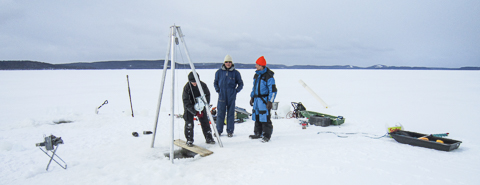Lake and marine sediment research
Geology Division of the University of Turku has a long experience in studying lake and marine sediments. Currently the focus of our lake and marine sediment research group is on annually laminated sediments with a high temporal resolution and excellent preservation, which is a prerequisite for high-resolution studies of climate and environmental change. Since 2002 several new varved sediment records have been found and studied from multiple points of views using a variety of analysis methods.
Our active research group uses modern technology and high-resolution studies, including modelling and digital image analysis, with chemical, physical, statistical and biological approaches in order to broadly explore environmental and climatic change and its causes, the background conditions and the future.
An important aspect of the work of our dynamic research group is to continuously developing and testing new equipment and technology for better in order to improve both sediment coring techniques and sediment core quality. We also collaborate enthusiastically with German, Japanese and Egyptian research groups for better understanding of sedimentary environments related to waters, climate and the backgrounds of the environmental and climate change. Welcome to our web pages to learn more about our research projects!
Study sites
Our study sites are the several inland lakes in Finland and the coastal areas of the northern Baltic Sea where our primary research focus is on the marine and lacustrine sediments. We are also involved in several international lake drilling and research projects in Asia and Africa
Material and Methods
We are mainly focused on annually laminated (varved) sediments which resemble tree rings. Tree ring growth is dependent on the seasonal conditions. In a smilar manner varves form on the lake bottom and the sea floor as a response to the seasonal cycle. The boreal nature is very different during winters and summers and the variation of the seasons is imprinted in the sedimentary fabric. The most common varve type in the boreal environment is a clastic-organic varve which comprises of three laminae. The varve year begins during the spring when melting snow causes floods. Minerogenic matter is eroded from the catchment to the water, and subsequently, these lithic particles settle down to form a light grey lamina on the bottom of the water body. During the growing season, organic matter accumulates on top of the minerogenic lamina. This growing season lamina is often dark brown and it consists of leaves and plant remnants, pollen, algae, and insect remnants that originate from the water body itself and from its catchment. . The third lamina is very thin and nearly black. It consists of very fine organic matter which settles down during winter, underneath the ice cover.
The three annual laminae enable studies at seasonal resolution. We are specialized on epoxy impregnation techniques in order to produce high-quality samples for varve counting and for physical and chemical analyses. We use high-quality x-ray radiographs and digital image analysis for calculating and measuring the varve thicknesses. The state-of-the-art microscope devices enable detailed microfacies analyses
Results and discussion
The advantage of using varved lake and marine sediments are the length and accuracy of the chronologies and the high resolution. With a seasonal resolution it is possible to study the seasonality and seasonal changes over the time.
Acknowledgements
We acknowledge Academy of Finland, Kone Foundation, Finnish Cultural Foundation, the Geological Survey of Finland, Alfred Kordelin Foundation, Olvi Foundation and Maa- ja vesitekniikan tuki ry.
